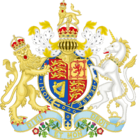Petroleum (Production) Act 1934 facts for kids
| Act of Parliament | |

|
|
| Long title | An Act to vest in the Crown the property in petroleum and natural gas within Great Britain and to make provision with respect to the searching and boring for and getting of petroleum and natural gas, and for purposes connected with the matters aforesaid. |
|---|---|
| Citation | 24 & 25 Geo. 5. c. 36 |
| Introduced by | President of the Board of Trade Walter Runciman (Second Reading) (Commons) Secretary of State for Air the Marquess of Londonderry (Second Reading) 19 April 1934 (Lords) |
| Territorial extent | Great Britain |
| Dates | |
| Royal assent | 12 July 1934 |
| Repealed | 15 February 1999 |
| Other legislation | |
| Repeals/revokes | Petroleum (Production) Act 1918 |
| Repealed by | Petroleum Act 1998 |
|
Status: Repealed
|
|
| Text of statute as originally enacted | |
The Petroleum (Production) Act 1934 was a special law passed by the Parliament of the United Kingdom in 1934. This Act made it clear who owned the oil and natural gas found deep underground. It stated that all petroleum and natural gas in Great Britain belonged to the Crown (which means the government, acting for the country).
This law also set up rules for finding, drilling for, and taking out (producing) petroleum and natural gas. To do this, companies or people had to get special permission, called a license.
Contents
Why This Law Was Needed
Before 1934, it wasn't clear who owned the oil found under someone's land. Imagine you owned a house; did you also own the oil beneath it? People had different ideas about this. For example, in 1919, a top legal expert, the Attorney-General, said that he thought the landowner probably owned the oil too.
This lack of clear rules made it hard for companies to explore for oil. Another law, the Petroleum (Production) Act 1918, had tried to help by saying people needed a license to look for oil. But between 1918 and 1934, only a few licenses were given out. Also, oil prices were falling in the 1920s, which made exploring for oil less appealing. The 1934 Act was created to fix these problems and make things clear.
What the Act Did
The Petroleum (Production) Act 1934 became law on July 12, 1934. When a law gets the "royal assent", it means the King or Queen has officially approved it.
The main goal of this Act was to give ownership of all petroleum and natural gas in Great Britain to the Crown. It also created a system for people to get licenses to search for, drill for, and produce these resources.
Key Parts of the Act
The Act had 11 main sections and an extra part called a schedule:
- Section 1: Said that petroleum now belonged to the Crown.
- Section 2: Explained how to get licenses to look for and produce petroleum.
- Section 3: Gave companies the right to enter land to explore, even if they didn't own it (but they had to follow rules).
- Section 4: Dealt with how natural gas could be supplied.
- Section 5: Explained how money from oil and gas production would be handled.
- Section 6: Gave power to make more detailed rules (regulations).
- Section 7: Allowed officials to check maps of mines.
- Section 8: Described the powers of the Board of Trade (a government department) in managing oil and gas.
- Section 9: Defined what "minerals" meant in the law.
- Section 10: Included some special exceptions.
- Section 11: Gave the Act its short name, canceled the old 1918 Act, and said where the law applied.
- Schedule: Contained extra details.
How the Act Changed Things
This Act made a big change by making the Crown the owner of all natural oil found underground. The Board of Trade was given the job of giving out licenses to companies or people who wanted to search for, drill for, and produce oil.
The Board of Trade could also create rules about how to apply for a license, how much it would cost, the size of the area a license would cover, and what the licenses should include. The Act also allowed the Board of Trade to check maps of underground mine workings. The older Petroleum (Production) Act of 1918 was officially canceled by this new law.
Many people thought the 1934 Act was a smart idea. It encouraged companies to look for oil, but it also made sure that this was done in an organized way, preventing uncontrolled drilling.
In 1935, new rules called the Petroleum (Production) Regulations were made. These rules included "Model Clauses" that were put into every license.
Years later, in 1959, a company called Shell wanted to look for gas in the North Sea. They asked if the 1934 Act could apply to areas of the North Sea that were under British control. The government said that new laws would be needed before licenses could be given for those areas.
The Act Today
The Petroleum (Production) Act 1934 was eventually replaced. It was canceled by a newer law called the Petroleum Act 1998.
See also
- Oil and gas industry in the United Kingdom
- Petroleum Act

